Chris Grinter By, uztailaren 25ean, 2011 This Monday I am departing from the usual Arctiinae for something completely different – microlep du! This is a Nepticulidae, Stigmella diffasciae, eta neurtzen whopping batean 6 mm. I can’t take credit for spreading this moth – all of the nepticulids I have photographed are from the California Academy of Sciences and spread by Dave Wagner while he was here for a postdoctorate position.
The caterpillars mine the upper-side of the leaves of Ceanothus and are known only from the foothills of the Sierra Nevada in California. If you’re so inclined the revision of the North American species of the genus is freely available here (.pdf).
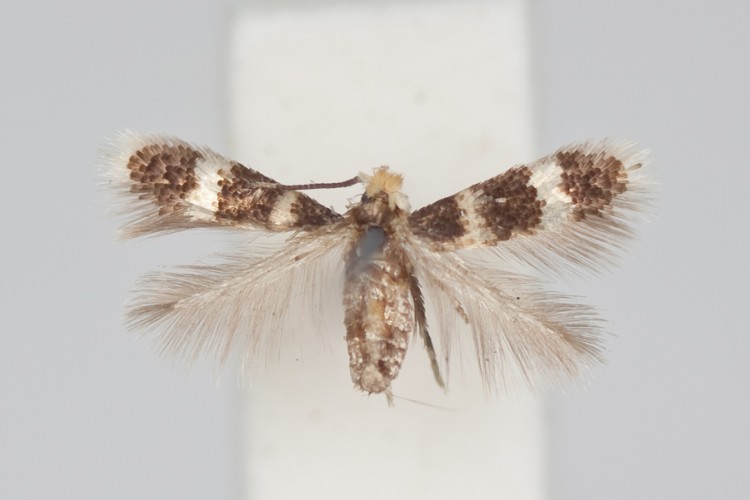 Stigmella diffasciae (Nepticulidoak)
Chris Grinter By, uztailaren 22an, 2011 Pixka bat ere izan da azken erronka geroztik GOP, baina hau sofbola da. Espero dut besterik ez too alferrak irudi egoki bat aurkitu ziren…

Chris Grinter By, on July 19th, 2011 What would Jesus do if he had some free time – maybe cure a disease, end a war, or feed the starving – but nah, everyone sees that coming. Why not shock them to the core – burn your face on a Walmart receipt! Gutxienez, that’s what a couple in South Carolina believe to have found, a Walmart receipt with Jesus’s face on it. This isn’t exactly new or exciting, humans have a wonderful ability to recognize a face in just about anything. Jesus and other characters “appear” on random things all the time, and even in 2005 a shrine was built to the Virgin Mary around a water stain in a Chicago underpass.
Pareidolia anyone? Benetan, that face looks pretty convincing, I’m not too sure this wasn’t just faked or “enhanced”. The closeups even look like there are fingerprints all over it. Since I don’t have a walmart anywhere near me or a walmart receipt on hand I can’t determine how sensitive the paper is and how easy it would have been to do – but how long do you think before it shows up on ebay? Nolanahi ere, it looks much more like James Randi to me than Jesus (at least we actually know what Randi looks like!).
 from CNN
Chris Grinter By, uztailaren 18an, 2011 Over Arthropoda on, ikaskide SFS blogger Michael Bok bere eremuan buddy irudi bat elkarbanatu, Plugg zuhaitz berde igel. My first thought was of a similar tree frog that haunted welcomed me everywhere I went in Santa Rosa National Park, Costa Rica. Esan beharrik ez, Costa Rica instills a sudden habit of double checking everything you are about to do. This species is known as the milk frog (Phrynohyas venulosa) for their copious amounts of milky white toxic secretions. One of the first stories Dan Janzen told me while while I was with him at Santa Rosa was about this species – and accidentally rubbing his eye after holding it. Thankfully the blindness and burning was only temporary.
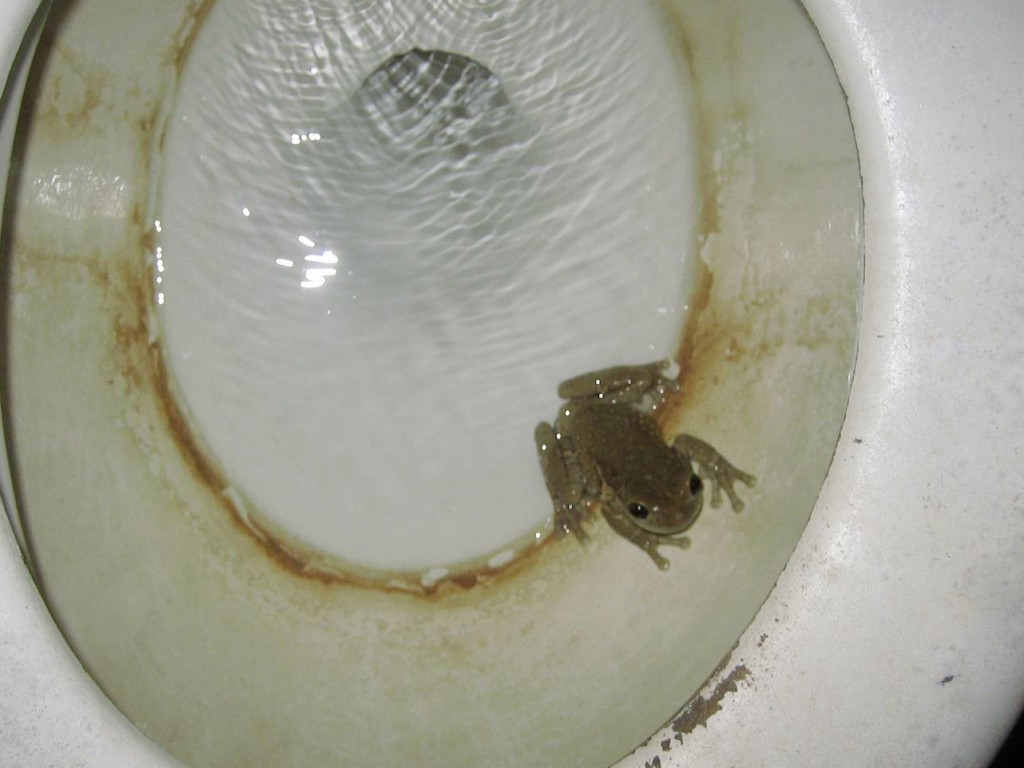 Milk Frog: Phrynohyas venulosa
Chris Grinter By, uztailaren 18an, 2011 I’ll keep the ball rolling with Arctiinae and post a photo today of Ctenucha brunnea. This moth can be common in tall grasses along beaches from San Francisco to LA – although in recent decades the numbers of this moth have been declining with habitat destruction and the invasion of beach grass (Ammophila arenaria). But anywhere there are stands of giant ryegrass (Leymus condensatus) you should find dozens of these moths flying in the heat of the day or nectaring on toyon.
 Ctenucha brunnea (Erebidae: Arctiinae)
Chris Grinter By, uztailaren 12an, 2011 Baita asmatu ahal izango duzu gaia ez da hunkigarriak nire izenburu gisa iradokitzen, baina ezin dut lagundu, baina Guardian article spin. Benetan barregarria iruditzen zait zientzialariak direla dioen edozer topatzen dudanean “Harrituta”, “nahasia”, “harritu”, “harrituta”, – Uste dut, denbora beste gai bat… Hala ere a benetan cool tximeleta sortu da “Sentsaziozko Tximeletak” Londresko British Museum-en erakusketa – aldebiko ginandromorfoa! The Guardian-ek jakinarazi du gaurko ale hau Papilio memnon sortu berri da eta bisitari kopuru txikiak biltzen hasia da. Badakit gustatuko litzaidakeela hauetako bat berriro bizirik ikustea – zoologikoaren egoerak zirrara dezente kenduko lukeen arren. Hauetako bat ikustea baino zirraragarriagoa dela uste dut soroan bizi neuk saretzea izango litzateke!
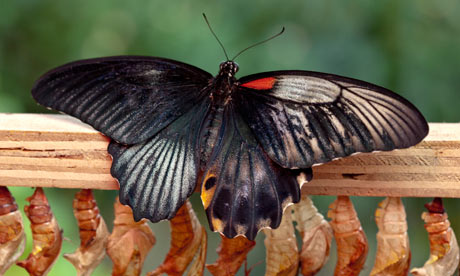
Gauza txiki batek nire sentsore eszeptikoek estropezu egin zituen eta hori da tximeleten komisarioari hartutako artikuluaren amaierako aipua., Baratze Zuriak. “Tximeleta ginandromorfoa fenomeno zientifiko liluragarria da, eta eboluzio-prozesu konplexuen produktua da. Zoragarria da museoko eremuetan eklosio bat aurkitzea, bereziki arraroak direnez.”
Beno, Ez dut zehazki ikusten hauek nola diren a “ren produktua … eboluzio-prozesuak” neurrian guztiak bizitzan guztiak forma eboluzioaren produktua da. Hauek antzuak dira “akatsak” politak direnak, baina ez berariaz alde edo aurka garatu den ezer. Beharbada, egokiagoa litzateke honi genetikaren prozesu liluragarri deitzea (artikuluak benetan zehaztasunez deskribatzen duena). Gainera – tximeletak heldu gisa sortzen dira eta beldar gisa sortzen dira – baina hori ni hautakorra naiz.
Chris Grinter By, Uztailaren 11n, 2011 Gaurko sits SE Arizona eta Mexiko espezie eder eta arraroa da: Lerina jasotako (Erebidae: Arctiinae). Like many other day flying species it is brilliantly colored and quite likely aposematic. After all, ostalari landare milkweed bat da, eta beldarra da bezain harrigarri (azpitik).
 Lerina jasotako (Erebidae: Arctiinae)
This image of an old, spread specimen hardly does the animal justice, but one lucky photographer found a female ovipositing at the very top of a hill outside of Tucson, Arizona. While you’re at it go check out some of Philip’s other great photographs on SmugMug.
 Lerina jasotako - Philip Kline, BugGuide As I mentioned above this moth also has an equally impressive caterpillar that feeds on Ascleapias linaria (pineneedle milkweed).
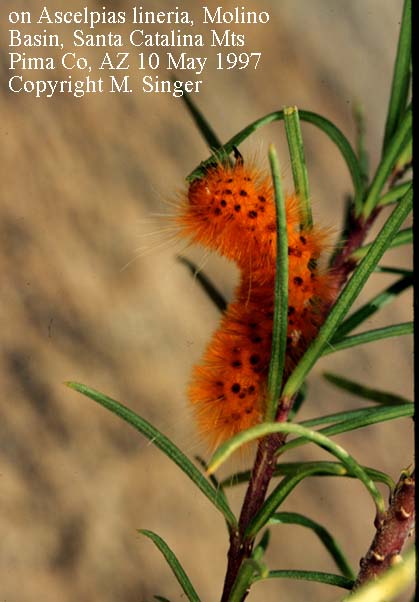
Chris Grinter By, uztailaren 5ean, 2011 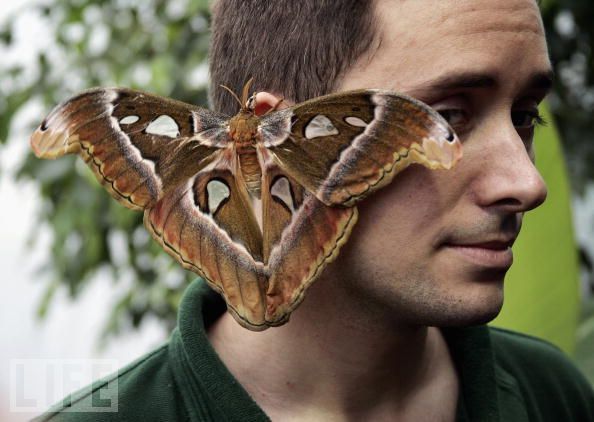
Hiri kondairak nagusitasun, gure aurpegiak sartu intsektuak lo bitartean arakatzeko inplikatzen da dirudienez. The most famous myth is something along the lines of “jan 8 armiarmak urtean, berriz, lo“. Actually when you google that the number ranges from 4 8… up to a pound? Not surprising things get so exaggerated online, especially when it concerns the ever so popular arachnophobia. I doubt the average American eats more than a few spiders over their entire lifetime; your home simply shouldn’t be crawling with so many spiders that they end up in your mouth every night! A similar myth is still a myth but with a grain of truth – that earwigs burrow into your brain at night to lay eggs. It isn’t true that earwigs are human parasites (thankfully), but they do have a predisposition to crawl into tight, damp places. It is possible that this was a frequent enough occurrence in Ye Olde England that the earwig earned this notorious name. Cockroaches have also been documented as ear-spelunkers – but any crawly insect that might be walking on us at night could conceivably end up in one of our orifices.
I have however never heard of a moth crawling into an ear until I came across this story today! I guess a confused Noctuid somehow ended up in this boy’s ear, although I can’t help but to wonder if he put it there himself… Moths aren’t usually landing on people while they are asleep nor are they that prone to find damp, tight spots. But then again anything is possible, some noctuids do crawl under bark or leaves in the daytime for safe hiding. I even came across another story of an ear-moth form the UK (not that the Daily Mail is a reputable source).
Naturalean, some lazy news sources are using file photos of “moths” instead of copying the photo from the original story. It’s extra hilarious because one of the pictures used is of a new species of moth described last year by Bruce Walsh in Arizona. Lithophane leeae has been featured on my blog twice before, but never like this!
On a closing note here is a poem by Robert Cording (also where the above image was found).
Consider this: a moth flies into a man’s ear
One ordinary evening of unnoticed pleasures.
When the moth beats its wings, all the winds
Of earth gather in his ear, roar like nothing
He has ever heard. He shakes and shakes
His head, has his wife dig deep into his ear
With a Q-tip, but the roar will not cease.
It seems as if all the doors and windows
Of his house have blown away at once—
The strange play of circumstances over which
He never had control, but which he could ignore
Until the evening disappeared as if he had
Never lived it. His body no longer
Seems his own; he screams in pain to drown
Out the wind inside his ear, and curses God,
Who, hours ago, was a benign generalization
In a world going along well enough.
On the way to the hospital, his wife stops
The car, tells her husband to get out,
To sit in the grass. There are no car lights,
No streetlights, no moon. She takes
A flashlight from the glove compartment
And holds it beside his ear and, unbelievably,
The moth flies towards the light. His eyes
Are wet. He feels as if he’s suddenly a pilgrim
On the shore of an unexpected world.
When he lies back in the grass, he is a boy
Berriz ere. His wife is shining the flashlight
Into the sky and there is only the silence
He has never heard, and the small road
Of light going somewhere he has never been.
– Robert Cording, Common Life: Poems (Fort Lee: CavanKerry Press, 2006), 29–30.
Chris Grinter By, ekainaren 30ean, 2011 
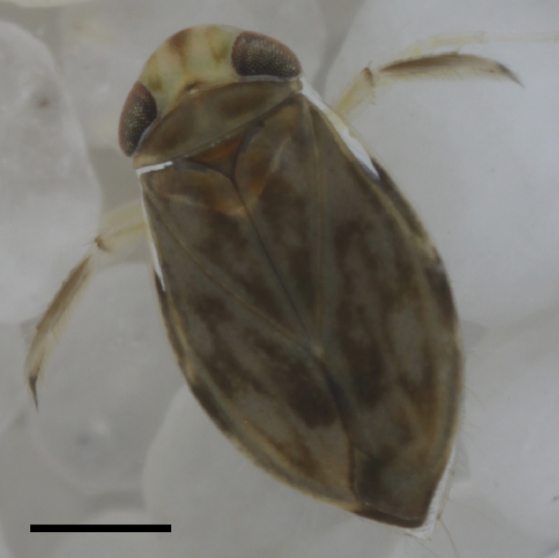 Micronecta Scholtz Europako landa mendietan bizirik dira maitasun koru, Garrasi, gizonezkoen uretako bugs. Goiko intsektu txikia, Micronecta Scholtz (Corixidae), 2,3 mm ikaragarrian neurtzen du eta, hala ere, klik / burrunba soinua erraz sortzen du gizakiarentzat entzungarria belarria uraren gainazalean. Hori ikuspegian jartzeko: igerileku ondoan dagoen bitartean norbait urpean hitz egiten entzutea ia ezinezkoa da, hala ere, intsektu txiki honek nahikoa klik ozen bat sortzen du lurreko artropodo batekin nahasteko. Horrek ez dirudi oso ikusgarria, zigarra bezalako beste intsektu ozenez inguratuta gaudenean, M. eskolaltzi animalia izugarri ozena dela bihurtzen da soinua gure belarrira heltzeko gorputzaren tamaina eta bitartekoa kontuan hartuta.. Jarri zenbakietan urpeko kliken intentsitatea irits daitekeen 100 dB (Soinu Presio Maila, SPL). Uzkur gaitzazu intsektuen munduan eta soinu-ekoizpen hau a berdina da jack mailua distantzia berean! Beraz, zer demontre ahalbidetu dio zomorro txiki honi zarata hori atera eta harrapariz betetako mundu batean ihes egitea?
Egileek berez adierazten dute zein harrigarriak diren emaitza horiek. Agerian geratzen den lehenengo gauza da uretako ontzigileek ez dutela entzumen harraparirik izan behar, funtsean igerian ari direlako edozein animalia txikirentzat fisikoki ahalik eta zarata handiena eginez.. Benetan hau ez da harritzekoa, urpeko harrapari gehienak ikusmenezko ehiztariak baitira (dragonfly larbak, ur zomorroak eta kakalardoak etab…). Oso litekeena da hautespen sexualak dei stridulatory hauen garapena maila harrigarrietara bideratzea.. Bigarren gauzarik harrigarriena argi geratzen da intsektu hauek gorputzaren tamainarekin zenbaterainoko ozentasuna duten grafikoki irudikatzen duzunean. Grafikoaren goialdean izurde izurdea dago (T. moztuta) bere sonar ospetsuarekin. Baina kanpoan dagoen handiena gure intsektu txikia da, beheko ezkerrean, soinuaren eta gorputzaren tamainaren arteko erlazio altuena duena. (31.5 bitarteko batekin 6.9). Ez da ezagutzen beste animaliarik hurbiltzen. Dena den, litekeena da beste uretako intsektu batzuen azterketa gehiago egitea antzeko emaitza harrigarriagoak ez badira ere!
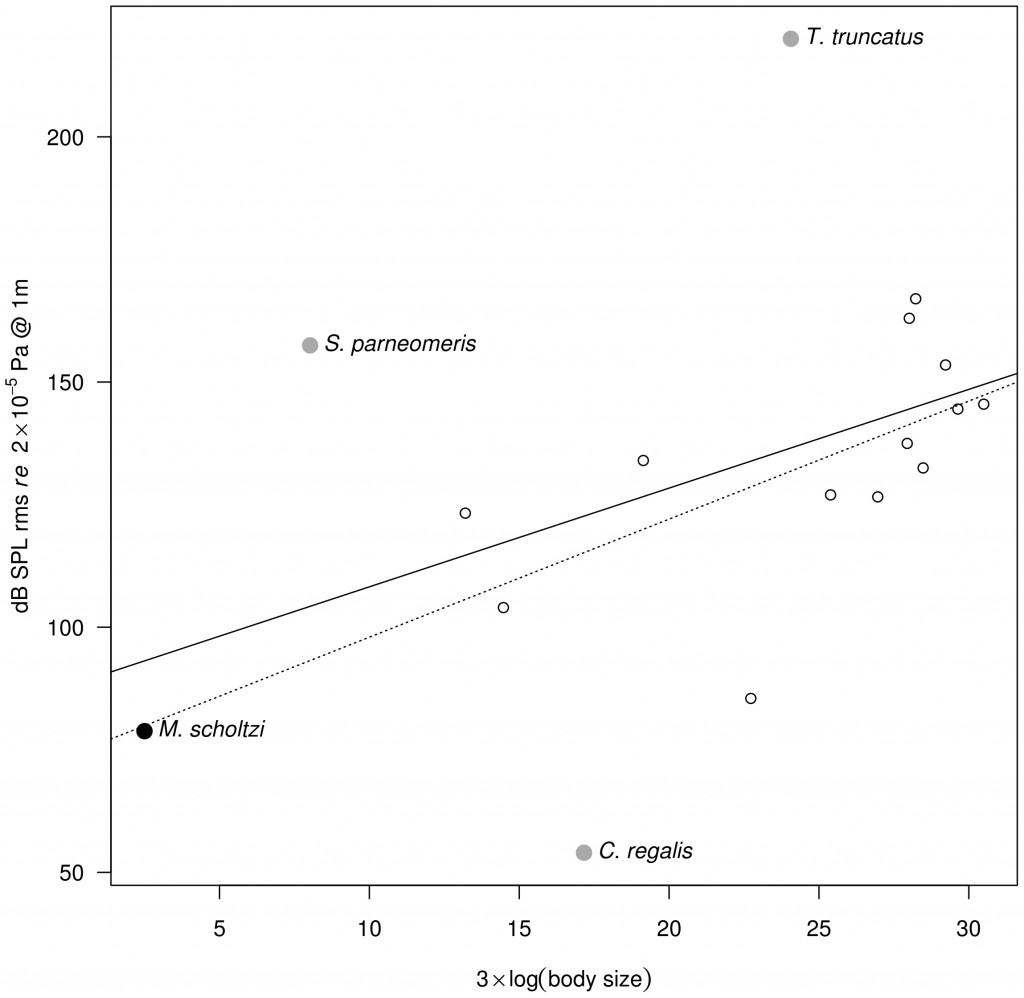
buruz zehatzagoa izateko “Garrasi”, akatsak (kasu honetan akatsak zuzena da; Corixidae hemiptera ordenakoak dira – benetako akatsak) litekeena da striduling egotea – bi zati elkarrekin igurtziz airea bota beharrean soinua sortzeko, danborrada, eta abar… Artikuluan egileek espekulatzen dute “soinua pars stridens eskuineko parameroan igurtziz sortzen da (genitalen eranskina) sabeleko zortzigarren segmentuaren ezkerreko lobuluko ertz baten aurka [15]”. Haien aipamenari tira egin gabe, Badirudi generoko arrek egindako estridulazioa bikotekidea erakartzeko ondo dokumentatuta dagoela. Eta espero zenuten bezala, albistegiek eta zientzia kazetariek irakurtzen dute “genitalen eranskina” eta itzuli hori zakila: eta istorioekin bukatzen duzu horrela. Parameroen funtzioa mandibulen antzekoa izan daiteke, egitura kontrajarriak direlako. (normalean ilez armaturik) harrapatzeko. The horien erabilera zehatza desberdina izan daiteke espezie edo baita ordenaren arabera, baina oso desberdinak dira zakilatik (=edeagus) estaltzea errazten laguntzen baitute eta ez dute espermarik ematen. Beraz, errealitatean genitalak dituzu “claspers” batekin “irrintzi zatia”. Eta pars stridens baten ilustraziorik onena amaitu da blog zaharra Arketipoa. Egitura hori azpian horiz nabarmentzen da (eta gertatzen da inurriaren sabelean). Baina, azken finean – garbigailu baten antzekoa den gainazal ildaskatu arrunta da. Azkenean goian aipatutako esaldia itzuli behar da “sabel-muturreko bi egitura igurzten diren bi hatz hausturak bezala”.
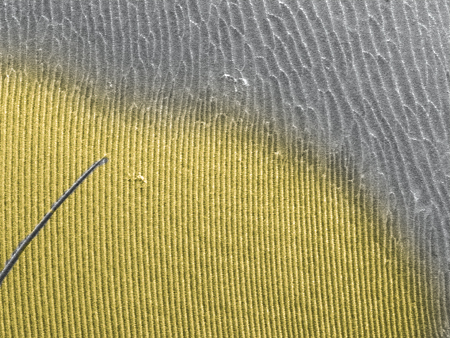 Pars stridens xehetasuna (horiz) laugarren sabeleko tergitan Pachycondyla villosa langile batean (Mikrografia elektronikoa, Roberto Keller/AMNH) Continue reading The incredibly loud world of bug sex
Chris Grinter By, ekainaren 20an, 2011 Baloia serie honekin errodadura mantentzeko eta erregular gehiago egiten saiatu naiz. I will also focus on highlighting a new species each week from the massive collections here at the California Academy of Sciences. This should give me enough material for… gutxienez, batzuk ehun urte.
 Grammia edwardsii (Erebidae: Arctiinae) This week’s specimen is the tiger moth Grammia edwardsii. Up until a few years ago this family of moths was considered separate from the Noctuidae – but recent molecular and morphological analysis shows that it is in fact a Noctuid. The family Erebidae was pulled out from within the Noctuidae and the Arctiidae were placed therein, turning them into the subfamily Arctiinae. OK boring taxonomy out of the way – all in all, it’s a beautiful moth and almost nothing is known about it. This specimen was collected in San Francisco in 1904 – in fact almost all specimens known of this species were collected in the city around the turn of the century. While this moth looks very similar to the abundant and widespread Grammia ornata, close analysis of the eyes, wing shape and antennae maintain that this is actually a separate species. I believe the last specimen was collected around the 1920’s and it hasn’t been seen since. It is likely and unfortunate that this moth may have become extinct over the course of the last 100 years of development of the SF Bay region. Grammia, and Arctiinae in general, are not known for high levels of host specificity; they tend to be like little cows and feed on almost anything in their path. So it remains puzzling why this moth wouldn’t have habitat today, even in a city so heavily disturbed. Perhaps this moth specialized in the salt marsh areas surrounding the bay – which have all since been wiped out due to landfill for real-estate (1/3 of the entire bay was lost to fill). Or perhaps this moth remains with us even today but is never collected because it is an evasive day flying species. I always keep my eye out in the park in spring for a small orange blur…
|
eszeptizismoa
|














